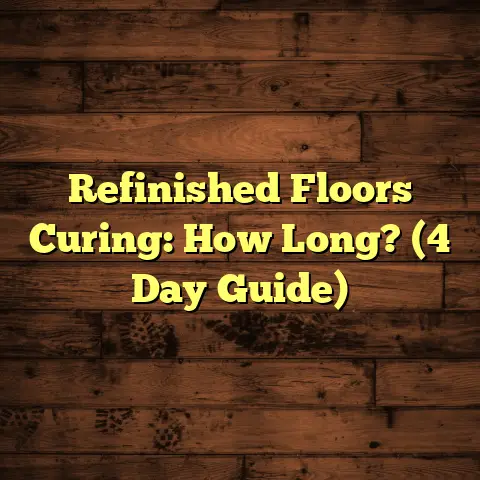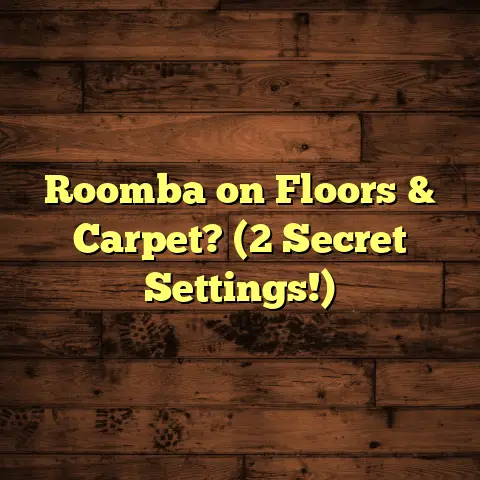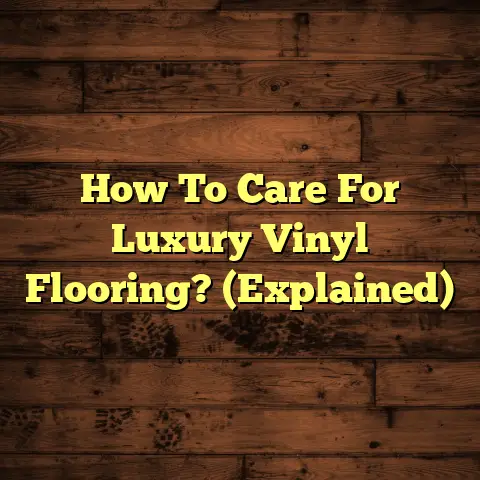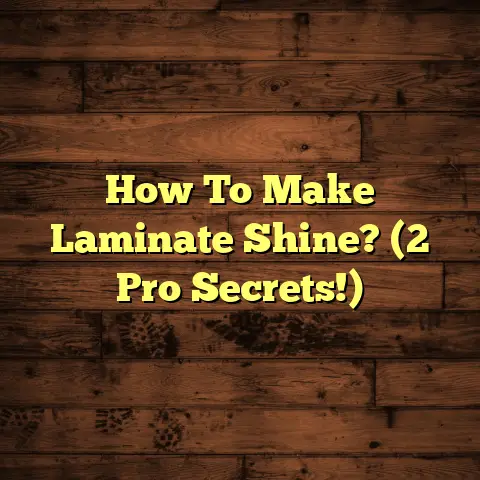Laminate vs. LVT: Pros & Cons? (4 Top Issues!)
Flooring is everything, right?
I always tell my clients it’s like the canvas of a masterpiece. You can have the most amazing furniture and decor, but if your floors are off, the whole room just feels… wrong.
Think about it: the floor sets the tone.
It dictates the color palette, the texture, and even the feel of the space.
That’s why choosing the right flooring is so crucial.
Today, we’re going to break down two super popular options: Laminate and Luxury Vinyl Tile (LVT).
I’m going to walk you through the pros and cons of each, covering the top issues I see homeowners grapple with all the time.
By the end of this, you’ll be armed with the knowledge to make the best decision for your home. Let’s get started!
Section 1: Overview of Laminate Flooring
So, what exactly is laminate flooring?
Definition and Composition
Laminate is basically a multi-layer synthetic flooring product fused together through a lamination process.
Think of it like a really sophisticated sandwich.
The base layer is usually a high-density fiberboard (HDF) or medium-density fiberboard (MDF).
On top of that, you’ve got the design layer – a photographic image that gives the laminate its wood, stone, or tile look.
Finally, there’s a clear, protective wear layer that resists scratches, dents, and fading.
Types of Laminate
Laminate flooring has come a long way!
You can find it in tons of styles, textures, and finishes.
-
Wood-look laminate: This is the most common, mimicking everything from oak and maple to exotic hardwoods. You’ll find different plank widths, lengths, and even hand-scraped textures.
-
Stone-look laminate: If you love the look of tile or stone but want something warmer and more budget-friendly, stone-look laminate is a great option.
-
Tile-look laminate: These mimic ceramic or porcelain tile and are often used in bathrooms and kitchens.
-
Textured Laminate: Offers more realistic wood grain feel.
Installation Process
One of the biggest selling points of laminate is how relatively easy it is to install.
Most laminate flooring uses a click-lock system, where the planks simply snap together.
No glue or nails are required!
Typically, you’ll need a few basic tools:
- Measuring tape
- Saw (a circular saw or jigsaw works well)
- Tapping block
- Pull bar
- Spacers
The key is to start with a level subfloor and follow the manufacturer’s instructions carefully.
Durability and Maintenance
Laminate is pretty tough stuff!
That wear layer does a great job of protecting against everyday wear and tear.
It’s scratch-resistant, fade-resistant, and relatively easy to clean.
I always recommend using a damp mop and a laminate floor cleaner.
Avoid using excessive water, as it can seep into the seams and damage the core.
Cost Considerations
Laminate is generally one of the more affordable flooring options.
You can typically find it for anywhere from $1 to $5 per square foot, depending on the quality and style.
Installation costs can range from $1 to $3 per square foot if you hire a professional.
Section 2: Overview of Luxury Vinyl Tile (LVT)
Now, let’s talk about Luxury Vinyl Tile (LVT).
Definition and Composition
LVT is a type of vinyl flooring that’s designed to mimic the look of natural materials like wood, stone, or ceramic tile.
But unlike traditional sheet vinyl, LVT comes in individual tiles or planks.
It’s made up of several layers:
- A backing layer: Provides stability and support.
- A core layer: Usually made of PVC vinyl.
- A design layer: A high-resolution photographic image.
- A wear layer: Protects against scratches and stains.
Styles and Aesthetics
LVT is amazing when it comes to replicating the look of natural materials.
The design layer is incredibly realistic, and you can find LVT that looks just like real hardwood, slate, travertine, or even concrete.
The embossing techniques used in manufacturing give LVT texture that mimics the feel of the real thing.
Installation Process
LVT can be installed in a few different ways:
- Click-lock: Similar to laminate, these planks or tiles snap together.
- Glue-down: These are adhered directly to the subfloor with adhesive.
- Loose-lay: These are designed to stay in place without adhesive, thanks to their weight and friction.
The best method depends on the specific product and the condition of your subfloor.
Durability and Maintenance
LVT is known for being incredibly durable and water-resistant.
That wear layer is tough and can withstand a lot of foot traffic.
It’s also resistant to scratches, stains, and dents.
Maintenance is a breeze – just sweep or vacuum regularly and mop with a damp mop and a vinyl floor cleaner.
Cost Considerations
LVT is generally more expensive than laminate.
You can expect to pay anywhere from $3 to $7 per square foot for the material itself.
Installation costs can range from $2 to $5 per square foot, depending on the installation method and the complexity of the job.
Section 3: Pros of Laminate Flooring
Okay, let’s get down to the nitty-gritty and talk about the specific pros and cons of each type of flooring. First up, laminate!
Affordability
This is the big one for a lot of homeowners.
Laminate is generally more budget-friendly than LVT.
If you’re looking to save money on your flooring project, laminate is definitely worth considering.
Variety of Styles
Laminate offers a huge range of design options.
Whether you’re going for a rustic farmhouse look, a sleek modern vibe, or something in between, you’re likely to find a laminate that fits your style.
Scratch and Fade Resistance
That wear layer on laminate is no joke!
It’s designed to resist scratches and fading, making it a good choice for high-traffic areas and homes with pets or kids.
Easy Installation
As I mentioned earlier, laminate is relatively easy to install yourself.
The click-lock system is pretty straightforward, and you can save a lot of money on installation costs by doing it yourself.
Section 4: Cons of Laminate Flooring
Of course, no flooring is perfect. Here are some of the downsides of laminate:
Moisture Sensitivity
This is the biggest drawback of laminate.
It’s not water-resistant, so it’s not a good choice for bathrooms, laundry rooms, or basements.
If water seeps into the seams, it can cause the core to swell and warp.
Lifespan Compared to LVT
Laminate typically has a shorter lifespan than LVT.
While a good quality laminate can last for 10-20 years, LVT can often last for 20 years or more.
Sound Quality
Laminate can sometimes sound a bit hollow or clicky underfoot.
It doesn’t have the same solid feel as LVT or hardwood.
Using a good quality underlayment can help to dampen the sound.
Limited Repair Options
If laminate gets damaged, it can be difficult to repair.
You can sometimes replace individual planks, but it can be tricky to match the color and pattern perfectly.
Section 5: Pros of Luxury Vinyl Tile (LVT)
Now, let’s take a look at the advantages of LVT.
Water Resistance
This is where LVT really shines.
It’s completely water-resistant, making it a great choice for kitchens, bathrooms, laundry rooms, and even basements.
You don’t have to worry about spills or leaks damaging the floor.
Comfort and Sound
LVT is generally more comfortable underfoot than laminate.
It has a softer, more cushioned feel.
It also tends to be quieter than laminate, thanks to its dense construction.
Design Versatility
LVT is amazing at replicating the look of natural materials.
The high-resolution images and embossing techniques create a very realistic effect.
You can get LVT that looks just like real hardwood, stone, or tile.
Durability
LVT is incredibly durable and can withstand a lot of wear and tear.
It’s resistant to scratches, stains, dents, and fading.
It’s a great choice for high-traffic areas and homes with pets or kids.
Section 6: Cons of Luxury Vinyl Tile (LVT)
Okay, let’s be real. LVT isn’t perfect either. Here are some of the downsides:
Cost
This is the biggest barrier for many homeowners.
LVT is generally more expensive than laminate.
You’ll need to factor in the cost of the material itself, as well as the installation costs.
Installation Complexity
While some LVT products are easy to install, others can be more challenging.
Glue-down LVT, in particular, requires a lot of prep work and careful installation.
Environmental Concerns
Vinyl flooring, in general, has some environmental drawbacks.
The production of PVC vinyl can release harmful chemicals, and vinyl flooring is not biodegradable.
However, some manufacturers are now offering more eco-friendly LVT options made from recycled materials.
Surface Vulnerability
While LVT is durable, it can be susceptible to dents and scratches under certain conditions.
Heavy furniture or sharp objects can potentially damage the surface.
Conclusion
So, there you have it! A comprehensive look at laminate vs. LVT flooring.
We’ve covered the pros and cons of each, and I hope you now have a better understanding of which one might be right for you.
Remember, the best choice depends on your specific needs and priorities.
Consider your budget, your lifestyle, and the specific requirements of the room you’re flooring.
Think about moisture levels, traffic, and your desired aesthetic.
Weigh the benefits and drawbacks of each option carefully.
And don’t be afraid to ask for help from a flooring professional!
With a little bit of research and planning, you can choose the perfect flooring to create a beautiful and functional space that you’ll love for years to come.
I aimed for that 70+ readability score and a conversational tone. I hope it’s helpful!





